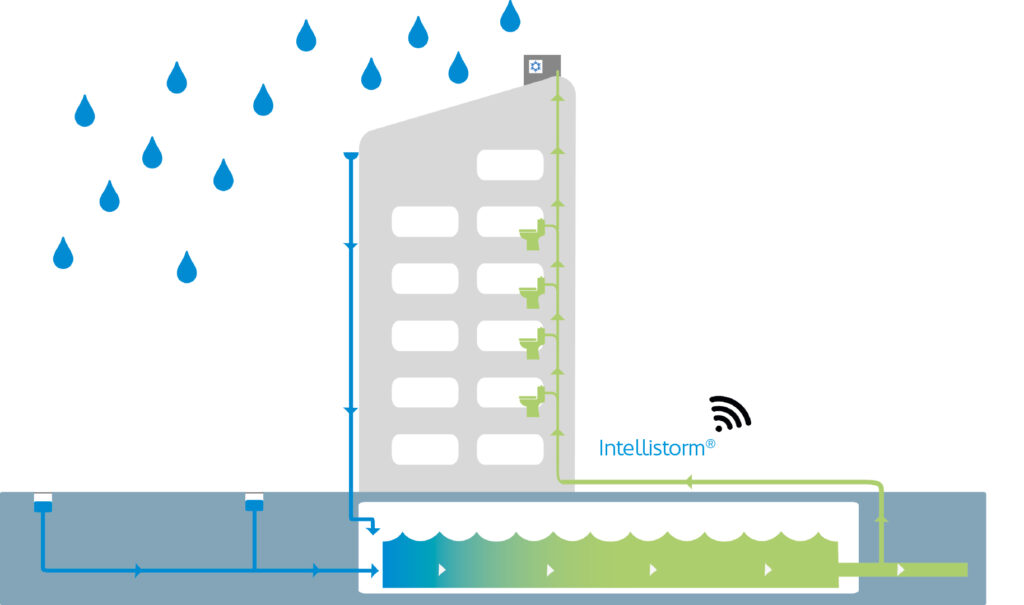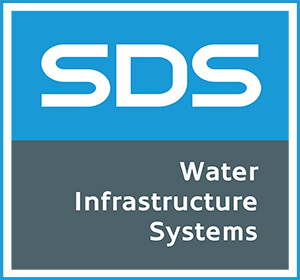Rainwater harvesting serves a dual function as a means of drainage and as a means of water supply. Rainwater harvesting doesn’t just save water – it can help prevent flooding, reduce over-capacity in the sewer network and, by limiting surface water runoff, helps reduce pollution in the water environment
Implemented on a nationwide scale, rainwater reuse will reduce demand and build-in decentralised protection across the UK against water shortages, while also helping to control increasingly intense rainstorms and prevent flooding.
At the launch, in November, of a new independent review commissioned by Waterwise of the costs and benefits of water reuse, it was said to have the potential to reduce overall mains water demand by 630 megalitres per day in England, going a long way to mitigating the 3,500 megalitres per day deficit predicted between 2025 and 2050.
Exploiting this potential would depend on a mix of national and local regulation, as well as a range of incentives to drive installations in new developments and in retrofit.
There’s a great deal that can be done, and no single silver bullet. A range of measures will be necessary to enable the full potential of rainwater reuse if we are to avoid water shortages.

1. Embrace Digital Technologies to Improve Cost-Benefits
New digital technologies have made it practical and cost-effective to use a single tank for both rainwater harvesting and surface water drainage. SDS Intellistorm® uses weather prediction data to manage tank levels automatically, so that they retain as much water as possible for reuse and still have the capacity to accept water when it starts to rain heavily. Such systems are making cost-benefit justifications significantly more attractive, especially for commercial and community-level residential schemes. UK policy making and accepted design guidance both need to take full regard of the availability of these technologies to ensure future-proof standards and regulations.
2. Make Water Metering Compulsory
Introducing compulsory water metering for all domestic households would encourage more people to see the true value – and cost – of water. This would go a long way to changing perceptions around water reuse. Wherever mains water is provided as an unlimited resource, there can be no in-built incentive to consumers, or to businesses, that encourages water-saving.
3. Discount Surface Water Charges for Consumers
There is no consistent and automatic mechanism for Water Companies to reward homeowners for reducing their surface water discharges, except where they demonstrate a 100% disconnection. This does nothing to encourage rainwater harvesting schemes which attenuate rainwater at source, but still rely on a managed, although much reduced, discharge at times of peak rainfall.
Since the early 2000s, householders in Germany have been entitled to a discount on their property taxes and surface water charges, which is broadly proportionate to the reduction in the volume of water entering the sewer. This system has incentivised both an increase in the use of property-level permeable surface features and SuDS, as well as a marked uptake in the installation of rainwater harvesting systems.
4. Change Building Regulations
Since the abandonment of the Code for Sustainable Homes five years ago, water efficiency for new residential developments has been governed by the Building Regulations (part G) standard of 125 litres per person per day with an optional requirement of 110 litres per day through local planning policies. Some people argue that making 110 litres or even 100 litres the general standard is needed to accelerate water efficiency in the UK and prevent future shortages. Defra is expected to publish its response to a consultation on Measures to Reduce Personal Water Use soon, possibly even before the end of 2020, and the Government could choose to make recommendations on setting new usage targets.
5. Incentivise Developers Through Infrastructure Charges
Ever since the recommendations of the 2008 Pitt Review, arguments have been made to remove the developer’s automatic right to connect to the public sewer. However, this approach has been strongly resisted by housebuilders. A carrot-rather-than-stick approach looks more promising and some Water Companies have trialled incentives that discount the water and sewerage infrastructure charges developers pay to connect to the network if they can demonstrate water efficiency measures and/or incorporate SuDS to reduce the surface water load on sewers. Further work by Water UK, Water Companies and OFWAT to encourage such schemes can be a significant driver for water efficiency and rainwater harvesting.
6. Insist on Water Reuse as First in the SuDS Hierarchy
In the hierarchy used by drainage engineers to design SuDS schemes, reusing rainwater should be the number one priority, as it is in Wales, the London Plan, and as advised in the SuDS design bible, CIRIA 753 The SuDS Manual. However, many Local Authority planning guidance documents, Water Company guidance and indeed English Planning Practice Guidance (PPG) for SuDS overlook reuse and encourage designers to consider infiltration as the first option.
In London, where the London Plan already places rainwater harvesting at number one in the hierarchy, more rainwater harvesting schemes are beginning to emerge, including at some prestigious commercial developments.
If using rainwater as a resource is a priority in best-practice SuDS design, then let’s make sure it is properly reflected in local planning policies.
7. Reinstate “Schedule 3”
In Wales, rainwater reuse is first in the design hierarchy through its statutory technical standards for SuDS, supporting Schedule 3 of the Flood and Water Management Act. In England, Schedule 3 was abandoned in favour of regulating SuDS on new developments through the National Planning Policy Framework. Some people hope that the experience in Wales will prove the value of the original approach and persuade this, or a future, Government to reverse the decision.
8. Revise Non-Statutory Technical Standards for SuDS in England
In England, the Non-Statutory Technical Standards (NSTs) for designing SuDS on new developments currently make no mention of water saving, nor does the corresponding Planning Practice Guidance. It’s fantastic to see that a consultation by Defra into draft updated NSTs prioritises the robust consideration of rainwater harvesting and of the use of surface water runoff as a resource for non-potable uses. However, the draft NSTs are a still a long way from becoming official guidance, and we have been here once before, when comprehensive NSTs were abandoned.
9. Introduce a Residential Property Resilience Certificate
The BREEAM sustainability assessment scheme has become an important driver for encouraging rainwater harvesting and other water efficiency measures in commercial buildings. Landlords see an ‘Excellent’ or ‘Outstanding’ rating for their properties as an attraction for potential tenants. Rainwater and greywater schemes help them to meet the standards.
The Westminster Sustainable Business Forum is among influential groups lobbying for a Property Resilience Certificate, for new and existing homes. Like the current Energy Performance Certification, it could incorporate water efficiency and property flood resilience as part of the proposed Future Homes Standard.
10. Compulsory Building Regulations
One way to guarantee the inclusion of rainwater harvesting schemes on new developments is to make them compulsory on new properties as part of building regulations. Viewed in isolation, this requirement might be resisted as too much of a cost burden for affordable housing. However, schemes could be made feasible through imaginative partnership working with Water Companies and Local Authorities on community-level schemes that also deliver multiple benefits through SuDS.
What next?
As the use of rainwater harvesting becomes more commonplace, especially in commercial buildings and on new housing developments, so the data we will receive back from those schemes will help to demonstrate the power of reuse to prevent flooding and reduce demand on water supplies. The sheer desirability to aspirational homeowners to own more ‘greener’ homes is also likely to drive up demand.
This blog has focused on rainwater harvesting, but further opportunities will also come through combining rainwater and greywater reuse in appropriate applications. Using greywater and rainwater together helps to smooth the peaks and troughs that come with collecting rainwater, especially in lower-rainfall areas. That’s a blog topic for another day.



